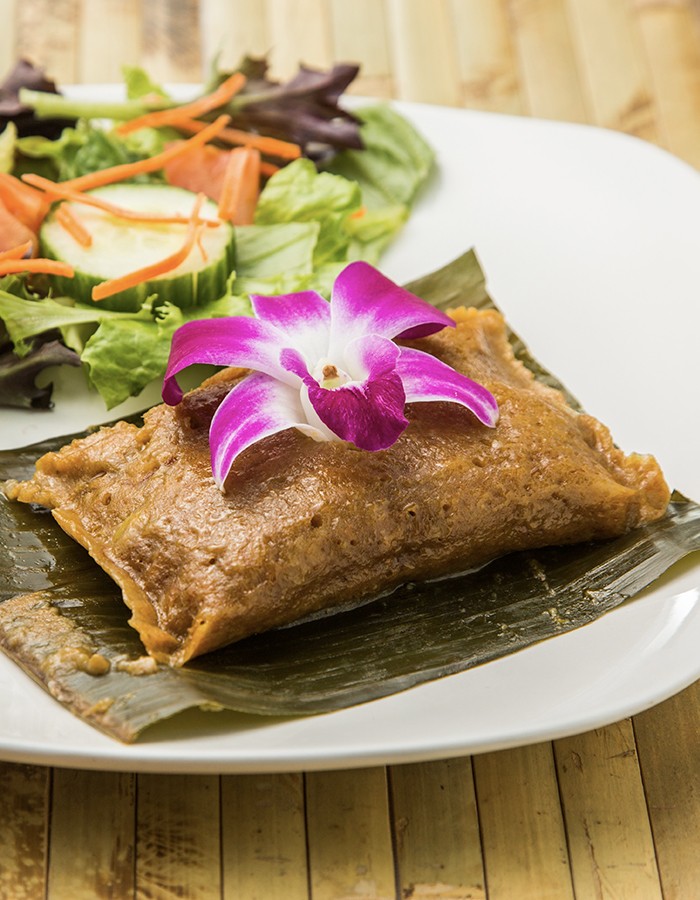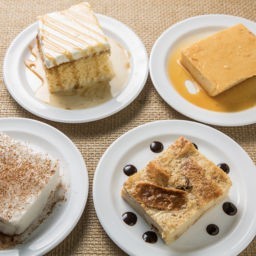
Puerto Rican pasteles, like the excellent ones served at the Freakin Rican in Queens, are “a project, not a quick fix,” Oswald Rivera writes in his 2002 cookbook, Nuyorican and Bodega Recipes. Traditionally, families on the island gather at Christmastime and pitch in for the laborious cooking duties, painstakingly grating down plantains, taro, and yams into a paste. They then wrap the uncooked delicacies to make them watertight. Accordingly, any good recipe includes diagrams for spreading the mixture on achiote-slicked plantain leaves, folding them into rectangular parcels, stacking them two at a time, and stringing them together in such a precise way that would make trussing a chicken look simple.
They look like a dark version of the more common-in-New York tamale and are generally boiled instead of steamed. The cooking takes about sixty minutes, which isn’t too bad since the whole process can take five hours or longer from start to finish.
The dish isn’t as readily available as other Puerto Rican staples across the city; La Fonda in East Harlem doesn’t offer them, nor does Sofrito in Hamilton Heights, which exclusively serves them during Thanksgiving and the winter holidays. And Casa Adela in the East Village, a gem of a cafe that’s been open since 1976, only sells them frozen for take-out. On a recent weekday, however, I called up the Freakin Rican, run by the island-born chef Derick Lopez, and his husband Victor Vargas, to see if they happened to be serving pasteles. “We serve them everyday,” a receptionist replied. The fluffy foodstuff, packed with fatty pork and olives, cost $5 apiece. They are excellent pasteles.

More Puerto Ricans live in New York than any city in the world, but the population has largely plateaued. Since the mid-aughts, Americans living on the Caribbean island have increasingly been moving to Florida amid economic turmoil and in the wake of devastating hurricanes. And while new Mexican and Peruvian restaurants open at a reasonably steady clip, venues serving Puerto Rico’s signature cocina criolla — a cuisine that reflects the territory’s indigenous, Spanish, and West African influences — are steadily vanishing. One of San Juan’s best new restaurants, after all, is reportedly the product of two Blue Hill alums who struggled with the prospect of paying rent in New York.
So the fact that the Freakin Rican even exists is impressive. The 40-year-old Lopez parlayed the success of a street stall into this stand-alone spot last May. It’s the rare new entry in a field dominated by older venues and serves all the staples: chunky mofongo, frothy guanabana shakes in tall glasses, and jelly-like coconut custards thickened.
But the pasteles are the true masterpieces. Lopez makes them out of plantains, pumpkin, and taro, employing an electric potato grater to make the labor easier, as is now common. He then stuffs them with stewed pork, lacing the masa with the swine’s rich cooking juices. A waiter brings them out unwrapped, each pastele sitting on top of plantain leaves. They’re as darkly green as seaweed. They glisten with achiote oil. They smell of smoke.
Pasteles are often silkier than tamales, but the flavor is more savory, as there’s no corn to impart sweetness. Here, the soft roots act as a neutral conduit for the powerful ingredients, from the saline pimento olives — they add a distinct brininess — to the musky bits of swine.
A select number of other shops also sell pasteles. Cuchifritos remains a reliable Harlem stalwart for the staple. Consider trying the chicken version there; it’s coarser, stickier, and richer than Lopez’s, with an overall flavor profile that’s less about the masa or olives and more about the meat. And Pasteles Cristina in Jamaica, Queens, is known for purveying a fine version of the namesake product as well.
That all said, I’ll argue that the Freakin Rican’s pasteles are an essential addition to New York’s Caribbean culinary landscape, and I’m calling the $5 treat a BUY.




